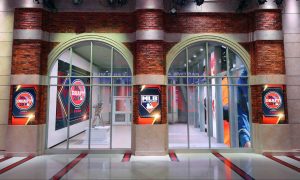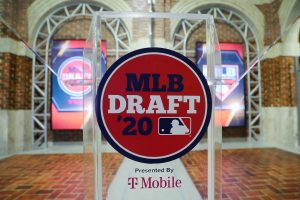MLB Draft 2020: MLB Network Embraces Virtual Event With 120 In-Home Feeds, Socially Distant Facility
The event will leverage three control rooms, studios in Secaucus, NJ
Story Highlights
As the league works to pinpoint a date to return to the diamond, all 30 franchises will take steps toward investing in their future with the 2020 MLB Draft on June 10-11. Similar to the efforts for the NFL Draft in late April, the production and operations teams of MLB Network are embracing the uniqueness of the event by capturing all 30 teams with 120 in-home camera feeds, leveraging a trove of offsite resources, and using every square inch of its facility in Secaucus, NJ.
“The past 11-12 weeks have prepared us well for the Draft,” says Susan Stone, SVP, operations and engineering, MLB Network. “If you had asked everybody [about these workflows] in February, this would be kind of foreign to us since we were just starting to dabble in that. But [now] it’s a lot less overwhelming, and it’s a lot more of the norm.”
Fly on the Wall: 120 Feeds Offer Fans a Peek at Team GMs, Prospects
With the coronavirus forcing the MLB Draft to forgo a physical gathering, the 11-year-old network has spent a good amount of time tinkering with production and operations plans. In a year with several alterations, the most notable deployment is being put into motion with the help of Dan Blanchard, senior director, media technology, MLB, and Neil Boland, chief information security officer, MLB.

While some staffers work from home, others from production and operations will be working at MLB Network’s headquarters in Secaucus, NJ.
“We’ve put 120 devices into the field — a primary and a backup — to every general manager and 23 prospects,” says Jason Hedgcock, director, remote technical operations, MLB Network. “T-Mobile sent out Apple iPhones, and they are running an app, called Larix Broadcaster, that allows us to control a lot of aspects of the stream. We’re able to decode the RTMP feed that’s created and turn it into our normal multicast.”
In addition to the iPhone, participating parties will be using a production kit comprising audio equipment and accompanying stands, an array of lighting fixtures to ensure the subject is well-lit, and more. The most difficult part, however, is teaching each individual how to use the kit correctly and getting everyone on the same page.
“There are several steps to setting this up,” says Jacob Soto, VP, operations, MLB Network, “so we developed one-sheeters and videos to walk people through the shots and other various things. It seems to have worked because, for those that went through the documentation, the signal came up and was easy to test.”
This concept, albeit for a different use, is familiar to the MLB Network team. Conditioned to delivering a heavy dose of games throughout the regular season, the crew is working alongside the infrastructure team to deliver a reliable and sustainable signal.
“The technology already existed, but what’s unique about this [project] is the scale: we haven’t ever done 120 signals for one given show,” Soto explains. “We’ve had to rely on them for their resources, so it has been cool to see how everyone has come together. [The infrastructure team] has tested every single phone with every single app and has monitored our streams to make sure that everything is going to work.”
In conjunction with ESPN’s presentation of this year’s Draft, the feeds being delivered to Secaucus will also be delivered to ESPN’s personnel in Bristol, CT.
Three-for-Three Day: Three Studios, Control Rooms Anchor Operations in Secaucus
Every year, Studio 42 at MLB Network headquarters in Secaucus has been the place where MLB superstars, such as Mike Trout and Aaron Judge, donned their new jerseys. Since this year’s Draft won’t be taking place there, all three studios (Studio 21, 3, and the aforementioned 42) will be used for onsite talent, including a designated area reserved exclusively for Commissioner Rob Manfred.
“In Studio 21, we will have the main body of the studio in one section with Greg Amsinger, Harold Reynolds, Dan O’Dowd, and Matt Vasgersian, who will be in chairs apart from each other,” says Marc Weiner, coordinating producer, MLB Network. “In another area, which we call the courtyard area, the commissioner will be with a camera, a podium, and some monitors behind him.”
Studios 42 and 3 will be used mainly for analytical breakdowns and live reports, with Al Leiter working off the pitcher’s mound in the former and Baseball America’s Carlos Collazo in the latter.
Similarly, all three control rooms within the facility will be in use. This will not only meet every need for this massive undertaking but also follow the necessary social-distancing guidelines from the CDC.
“It has been certainly great to be back and making live television in our control rooms,” says Stone. “We’ve had to take a lot of precautions and rethink how we do things, so one control room that would normally do a show is spread out into three. There has been a lot of tape-measuring going on to make sure there’s the proper amount of distance.”
Working Remotely: Offsite Teams, Talent Supply Additional Broadcast Help
While a good chunk of staffers are located in northern New Jersey, the production will be receiving help of different varieties from other settings. For immediate needs, a sizable number of employees will be lending a hand on the transmission front.
“We’re divvying up our remote-operations team to support the remote cams,” says Stone. “A majority of them are going to be working from home with Unity comms. They each have a set number of either prospects or GMs who they’re helping check in and troubleshoot.”
The main cog in this year’s efforts will not be alone in receiving offsite assistance. Graphics staffers will be inserting on-air information and templates from the comfort of their own homes. And, from a production perspective, a pair of MLB reporters and a collegiate head coach will be providing commentary from their respective locations.
“Remotely, we’ll have Tim Corbin, head baseball coach of the defending College World Series champions Vanderbilt University, at their studios,” says Weiner. “In addition, we will have Jim Callis and Jonathan Mayo from MLB.com on remote from their homes in Pittsburgh and Chicago.”
To capture feeds from Callis’s and Mayo’s homes, the network installed CP Communications’ remote PTZ camera systems that work off bonded cellular or an internet connection.
If there have been any obstacles in this period, they have derived from a failure to communicate. To avoid any mishaps, operations will hand Weiner and his staff a boatload of content all at once during the show.
“From the technological side, one thing that will help us a bit on Draft Day is scaling up and bringing all of the [content and feeds] into acquisitions at the same time,” says Hedgcock. “Originally, we had discussed working with some outside vendors and having them deliver everything in smaller groups, but that would have been a lot more complicated to manage.”
Furthermore, conversations with counterparts allowed an open conversation on how to rectify potential problems.
“The NFL and ESPN, who participated in the NFL Draft, were very transparent about how they did things, so we spoke to some friends and colleagues at the NFL Network as well,” says Stone. “I think we all are at a point where we work together, support each other, and share best practices.”
Draftee’s Story: Highlight Packages, Features, Fan Integration
Baseball fanatics may know a lot about this year’s Draft class, but, for the casual fan, the names may not evoke memorable collegiate moments or their up-to-date slash line. To set the table, Weiner and company will have a full catalog of footage to explain the prospects’ athletic achievements and give insight to their backstories. This year, though, the process came with a bit of a twist.
“In the past, we would select a handful of stories we wanted to tell and do your standard feature,” says Weiner, “but, obviously, we didn’t want to send [reporters] out into the world that we’re in right now. We told [prospects] they were going to be doing a zoom interview with a host, but we would surprise the player with somebody else who’d be doing the interview. For example, Carson Tucker is a player in the Draft this year, and his brother Preston plays for the Pittsburgh Pirates, so we had [Preston] interview his brother.”
As the lifeblood of the league, MLB Network will put a few fans at the center of attention during the festivities. More important, they will be ones currently on the front lines of the coronavirus pandemic.
“We’re going to be honoring front-line heroes,” says Weiner. “We’ve requested to spread it out throughout both days of coverage, but various personnel will be the ones putting their team on the clock.”
One To Remember: MLB Network Combines Traditional Techniques, New Ideas
Along with around-the-clock coverage of America’s national pastime, MLB Network has become synonymous with coverage of the MLB Draft. Turning amateur athletes into future All-Stars is now the network’s specialty, and its production and operations teams come up with new methods that may have a lasting impact.
“I think this is putting us on the forefront of what’s to come,” notes Hedgcock. “Whenever we move out of the pandemic age and back to the old normal, this is all technology that will be vetted, proven, and will be able to be used in creative ways in the future. It’s forcing us to do and look at some things a little differently, but it’s also giving us a whole new platter of production tools that will be able to do amazing things when we get everything back.”
Even with these new ideas, the philosophy behind the production draws on the problem-solving skills the network has deployed since its inception.
“We’re challenged every season by the production group,” says Soto. “They’ll ask us for something completely new, and we’ll always put it together. Even though it’s a different scale, solving little and big problems is just what we do.”
MLB Network’s coverage of the 2020 MLB Draft will span two consecutive days, with the First Round and Competitive Balance Round A beginning at 7 p.m. ET on Wednesday, June 10 and the second through fifth rounds beginning at 5 p.m. on Thursday, June 11.


